Mesquite Trees: Types, Leaves, Flowers, Bark – Identification Guide (With Pictures)
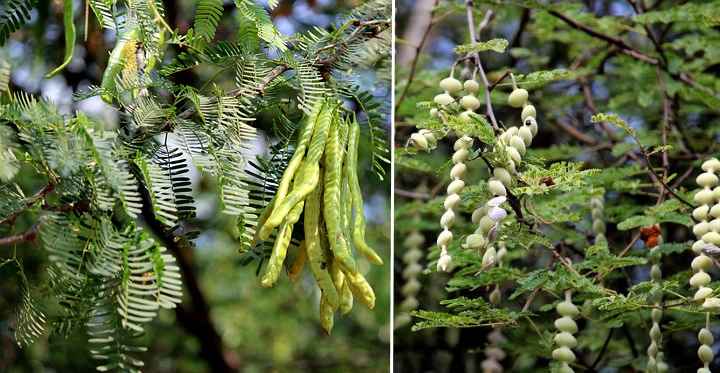
Mesquite trees are short, thorny shrub-like trees with feathery leaves, white or yellow flowers, and seed pods containing peas. Mesquite trees commonly grow in shrublands in Texas, Arizona, and other states in the southern US. The most common types of mesquite trees are the honey mesquite tree (Prosopis glandulosa), velvet mesquite tree (Prosopis velutina), and screwbean mesquite tree (Prosopis pubescens).
In many states like Texas and California, mesquite trees can be a nuisance for landowners. The tough shrubby trees have extensive root systems that stretch for up to 200 ft. (60 m). Also known as “trash trees” or “devil trees,” mesquite tree roots absorb water, preventing other plants from growing near them in the hot southern states. However, mesquite is a nitrogen fixer which means that it increases the nitrogen content in the soil and may improve its fertility.
This article is a guide to identifying mesquite trees. Along with pictures of mesquite trees, descriptions of their leaves, flowers, and bark will help you recognize different mesquite tree species.
Mesquite Tree Facts
Mesquite is the name for several large deciduous shrubs or small trees in the genus Prosopis and pea family Fabaceae. Mesquite shrubs and trees can be a few feet tall or grow up to 50 ft. (15 m). From the 40 species of mesquite, around seven are native to Texas, California, and Northern Mexico.
Due to their vast, spreading roots, mesquite trees are tolerant of drought and can survive low light. You can find mesquite trees growing in deserts, grasslands, along streams, and on hillsides. Because of their fast growth and extensive root system, mesquite plants are considered invasive in some areas.
In shallow soil, mesquite plants grow as low, multi-branched shrubs that only reach about 3 ft. (1 m) high. In deep soil, mesquite trees have a vase or rounded shape and grow to between 30 and 50 ft. (9 – 15 m) tall. The vast spreading canopy can grow up to 40 ft. (12 m) across.
Mesquite trees thrive in USDA zones 7 through 11 in full sun and well-draining soil.
The common name mesquite is a Spanish word that comes from the Aztecan word mizquitl. In Mexico, the trees are known as árbol de mesquite, or simply—mesquite tree.
Mesquite Tree Leaves

The leaves of mesquite tree are compound pinnate
The delicate fern-like leaves identify mesquite trees. The feathery mesquite leaves are compound pinnate with 20 to 50 small oblong leaflets arranged on a stem (petiole). Mesquite tree leaves are a green or grayish-green color and grow sparsely on trees.
Mesquite leaves are typically between 8” and 10” (20 – 25 cm) long.
The most common mesquite trees in Texas—the honey mesquite and velvet mesquite—have bipinnate compound leaves.
Mesquite trees drop their leaves when the weather turns cold. However, if the weather is relatively warm, the foliage stays on mesquite trees until new leaves start growing in spring. Only when young feathery leaves start growing does the tree shed its old leaves.
Mesquite Tree Thorns
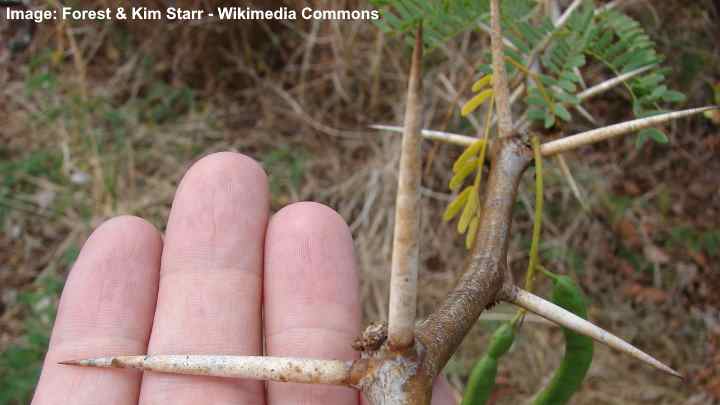
Mesquite thorns – in the picture the thorns of Prosopis juliflora
Mesquite trees are characterized by their stiff, sharp, pointed thorns. The spikes on thorny mesquite trees grow up to 3” (7.5 cm) long. The strong, stout mesquite spines can cause a lot of pain if you come into contact with them. Mesquite thorns can cause allergic reactions in some people.
The slender, sharp thorns on shrubby mesquite plants make them ideal for planting as a defensive hedgerow.
Some mesquite trees are spineless hybrids. If you want to grow a mesquite tree in your backyard, choose a cultivar with no spines. Or you can prune spines off young trees, and they won’t regrow as the tree matures.
Mesquite Tree Bark
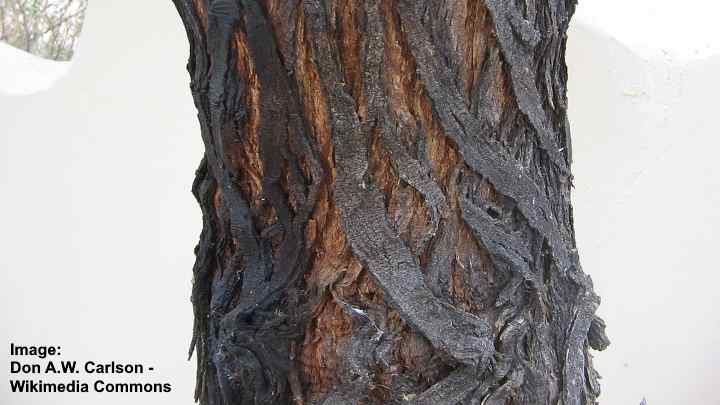
Bark of mesquite – picture of honey mesquite (Prosopis glandulosa) bark
Mesquite tree bark looks rough and scaly and is typically a reddish-brown color. Depending on the species, mesquite bark can be almost black, or it can be light brown. Young mesquite trees tend to have thin, light-colored bark. But the bark becomes fissured and darker as the tree matures.
The bark on mesquite trees also has a spiky appearance due to the straight thorns.
Mesquite Flowers
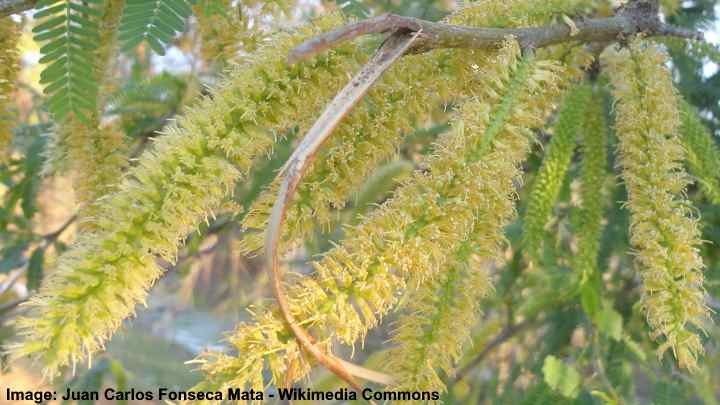
Mesquite flowers – picture of smooth mesquite (Prosopis laevigata) flowers
Mesquite flowers are long cylindrical white or yellow spikes called catkins. The pale-colored fragrant flowers grow between 2” and 3” long. Mesquite trees are in bloom during spring and summer. The clusters of pale-yellow flowering spikes give mesquite trees plenty of ornamental value.
Mesquite Seed Pods (Mesquite Fruit)
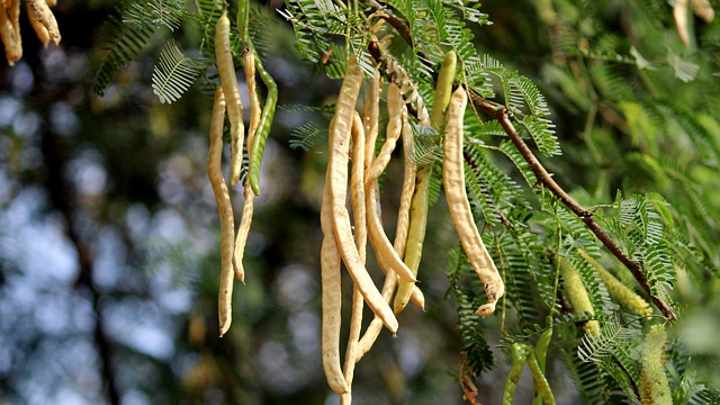
Mesquite (Prosopis juliflora) seed pods
Mesquite fruit grows as unusual, long seed pods containing bean-like seeds. When mature, the yellowish or reddish-brown pods grow between 10” and 12” (25 – 30 cm) long. The edible mesquite seeds ripen in July and August and have a sweet coating, making them popular with humans and wildlife.
The most unusual mesquite seed pods grow on screwbean trees. These pods look like a tightly wound screw or spring. Pictures of mesquite seed pods from other species show that typical mesquite pods are more like slender runner bean pods.
Mesquite Wood
Mesquite tree wood is a dense hardwood that is dark brown in color. The intricate wood grain gives lumber from mesquite trees ornamental value. The wood’s hardness and natural beauty make it ideal for making furniture, flooring, fence posts, and paneling. Mesquite wood is suitable for firewood, and it’s used in cooking with smoke to give food a unique flavor.
How to Identify Mesquite Tree
The best way to identify mesquite trees is by their feathery compound leaves. The delicate leaves look like mimosa leaves, with clusters of leaves growing sparsely on the branches. You can also recognize mesquite trees by their spiky bark and branches, as well as multiple stems that form a large, sprawling canopy.
Types of Mesquite Trees
The three most common mesquite tree types are the honey mesquite, velvet mesquite, and screwbean mesquite. Other types of mesquite trees are found in the Southwestern US, Northern Mexico, and South America. Let’s look in more detail at how to identify mesquite trees.
Honey Mesquite Tree (Prosopis glandulosa)
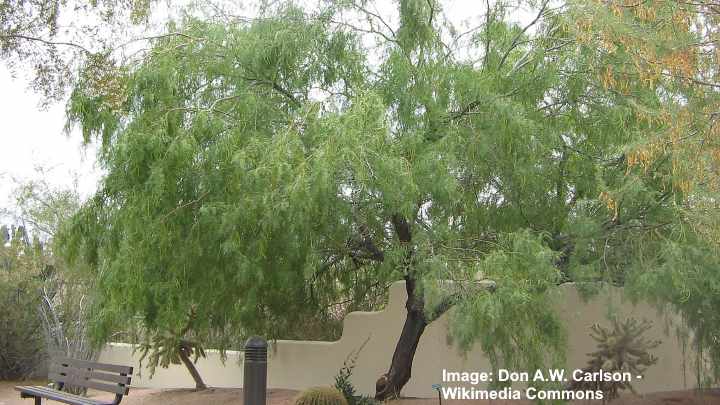
Honey Mesquite (Prosopis glandulosa) tree
The honey mesquite tree has long drooping branches, feathery leaves, yellow flowers, long tubular seed pods, and spiny branches. These trees have a spreading, rounded crown with shiny foliage hanging from their branches. Honey mesquite bark is rough and fissured and a reddish-brown color. Honey mesquite trees grow up to 40 ft. (12 m) tall and wide.
You can tell honey mesquite trees growing in the desert landscape by their crooked trunk that grows to one side.
The honey mesquite is found in Texas, Southern California, Arizona, and Northern Mexico. The tree is so common in the Lone Star State that it is also called the Texas honey mesquite.
Honey mesquite trees are grown as ornamental landscape trees for summer shade. If planting this mesquite species in your backyard, it’s best to look for thornless cultivars. Honey mesquite trees grow best as specimen trees or lawn trees. The delicate foliage creates dappled shade in sunny backyards.
To grow honey mesquite trees, plant in well-draining soil where the tree gets plenty of sunshine. The trees grow fast and are not fussy about the type of soil. Water monthly to grow robust trees with a large crown. Prune young trees rigorously to remove thorns and suckers that extend from the ground. This helps to develop a single-trunk mesquite tree with a large, spreading canopy.
Identifying honey mesquite trees
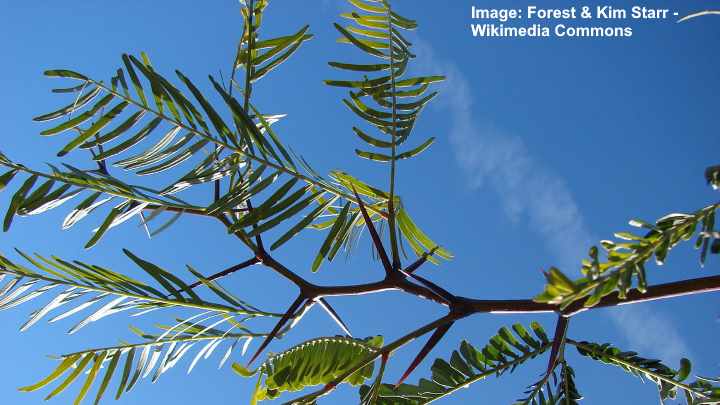
Honey Mesquite leaves and thorns
Honey mesquite tree leaves are bipinnate compound feathery leaves. Its leaves are a bright green color and grow up to 8” (20 cm) long. Each leaf has between eight and twenty pairs of oblong leaflets with rounded ends. The fern-like foliage creates a rounded crown.
Honey mesquite thorns are a reddish-tan color growing up to 2” (5 cm) long on twigs, branches, and the trunk.
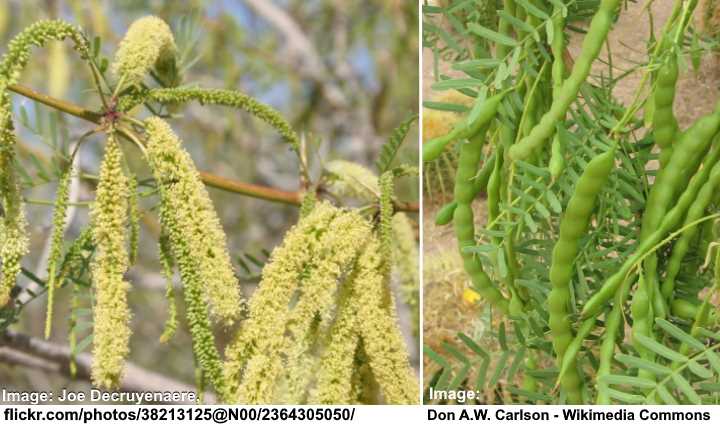
Honey Mesquite flowers and immature seed pods
Honey mesquite flowers are pale-yellow and grow in conical clusters that dangle from thorny branches. The mesquite tree blooms in early spring and the flower spikes last until late summer.
Honey mesquite tree seed pods are yellowish when mature and look like a pea pod. The pods contain ten to twenty seeds and look like a string of beads dangling from branches.
Velvet Mesquite Tree (Prosopis velutina)
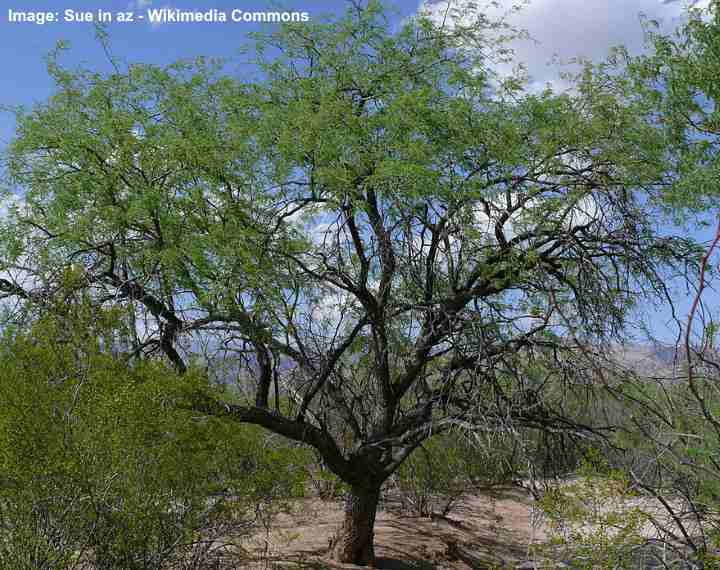
Velvet Mesquite (Prosopis velutina) tree
The velvet mesquite tree is a small to medium-sized deciduous tree with fern-like gray-green leaves, pendulous spikes of pale yellowish-green flowers, and dark reddish-brown shaggy bark. The velvet mesquite tree grows up to 25 ft. (7.5 m) tall, and its spreading vase-shaped crown measures around 35 ft. (10 m) across.
Velvet mesquite shrubby trees are native to Southern Arizona. You can find velvet mesquite growing in dry grasslands or beside streams in damp ground. Usually, velvet mesquite trees have multiple stems with expansive, spreading growth.
You can grow velvet mesquite trees in sunny backyards. The shrub’s tolerance for drought means you rarely need to water them. Pruning young trees is vital for removing thorns and developing an attractive shape. The best type of soil for velvet mesquite trees is porous, sandy soil.
Velvet mesquite trees are popular trees in Arizona for growing in xeriscape landscapes because they hardly ever need any water.
Identifying velvet mesquite trees
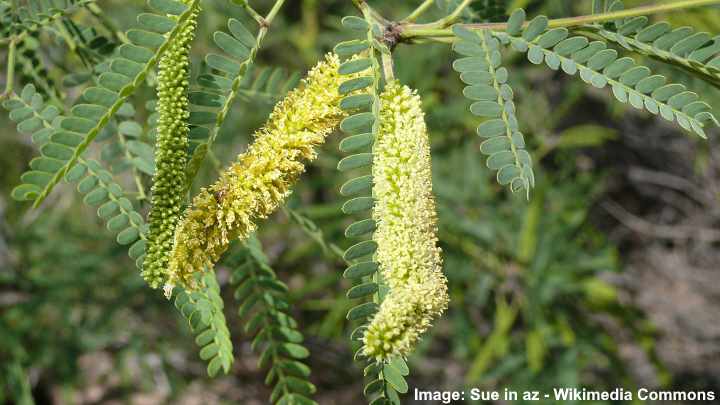
Velvet Mesquite leaves and flowers
Velvet mesquite tree leaves are feathery leaves that look like mimosa leaves. The grayish-green bipinnate leaves grow up to 6” (15 cm) long. In cold weather, the deciduous trees shed their leaves. However, in warm Texas and Arizona winters, the leaves may stay on the tree until spring.
Velvet mesquite trees get their name from the fine like hairs that give leaves a velvety feel.
Velvet mesquite flowers appear in late spring and are catkins of pale-yellow flowers. The cylindrical spikes grow in dense clusters and hang from spiny branches. The sweetly-scented flowers attract bees and pollinators in summer.
Velvet mesquite thorns are stiff and have a sharp point. The yellow mesquite thorns measure up to 1” (2.5 cm) and grow on young branches. You can make a mesquite tree thornless by pruning off the spines from immature trees.
Velvet mesquite seed pods are long, bright green pods that look like pea pods. The mesquite pods grow between 3” and 9” (7.5 – 22 cm) long.
Screwbean Mesquite Tree (Prosopis pubescens)
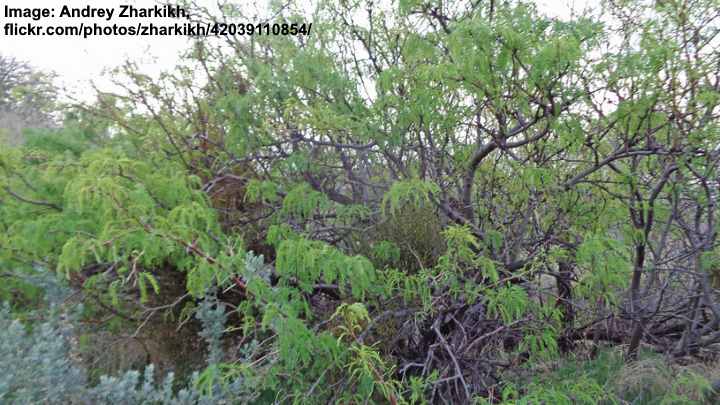
Screwbean Mesquite (Prosopis pubescens) tree
The screwbean mesquite tree is a large, multi-stemmed shrub or small tree with small yellowish flowers, small pinnate leaves, unusually twisted seed pods, and flaky brown bark that easily peels. Screwbean mesquite trees grow up to 23 ft. (7 m) tall with an open, spreading vase-shaped crown.
The screwbean mesquite tree is native to Southern Arizona, Texas, and New Mexico. You will find screwbeans growing in deserts, next to streams, or in damp, marshy ground.
Also called the screwpod mesquite or Tornillo, this Prospopis species is different from other mesquite trees. First, the unusual seed pods look like pale tan-colored plump caterpillars dangling in clusters from the tree. Additionally, screwbean tree leaves and thorns are smaller than the honey mesquite or velvet mesquite.
Grow screwbean mesquite trees in ground that has excellent drainage and where it gets plenty of sunshine. Prune the screwbean trees regularly to maintain their shape. Pruning immature trees is useful to get rid of the suckers if you want to grow a single-stem tree.
Identifying screwbean mesquite trees
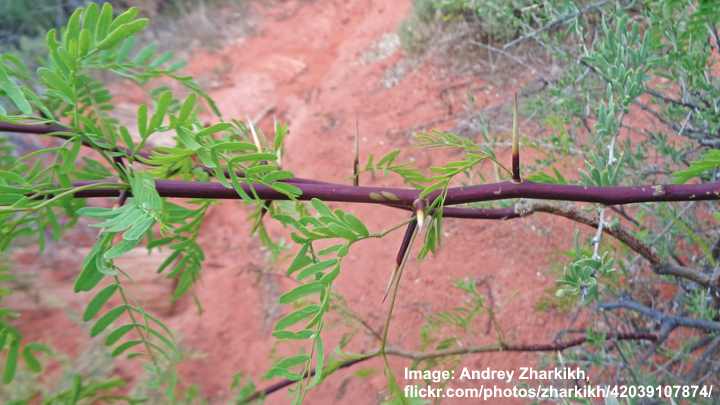
Screwbean Mesquite leaves and thorns
Screwbean mesquite tree leaves are small blue-green, pinnately compound leaves with up to 9 pairs of tiny leaflets. Leaves usually measure around 3” (7.6 cm) long, which make them the smallest of the native mesquite varieties.
Screwbean mesquite thorns are straight spines that don’t grow longer than 1.2” (3 cm).
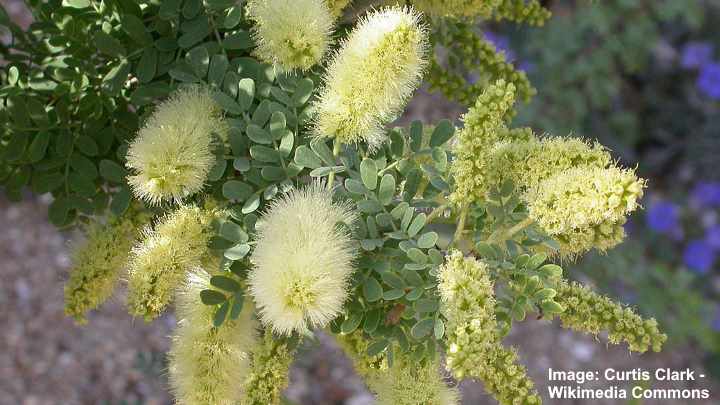
Screwbean Mesquite flowers
Screwbean mesquite flowers are yellow or white and grow as conical spikes 3” (7.5 cm) long.
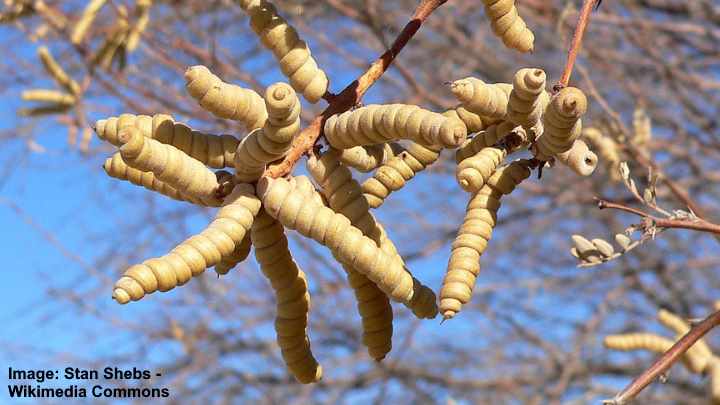
Screwbean Mesquite seed pods
Screwbean mesquite has twisting seed pods that look like a turned screw or spiral tubes. The coiled mesquite seed pods grow in clusters and point in all directions. Both the English name (screwbean) and Spanish name (Tornillo) refer to the unusual screw-like pods.
Chilean Mesquite Tree (Prosopis chilensis)
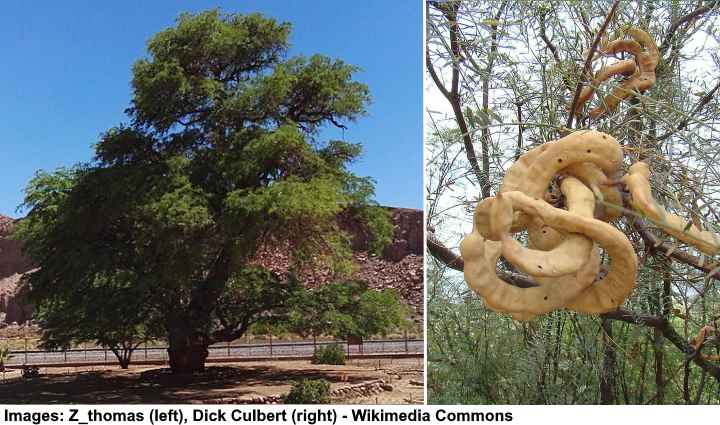
Chilean Mesquite tree and seed pods
The Chilean mesquite tree is a heat-loving, drought-tolerant tree with light, feathery foliage, twisting branches, and yellowish-green flowers. The mesquite flowers bloom from spring until summer and are followed by long yellowish-brown seed pods. This fast-growing tree has few care requirements. Chilean mesquite trees grow up to 30 ft. (9 m) tall and 40 ft. (12 m) wide.
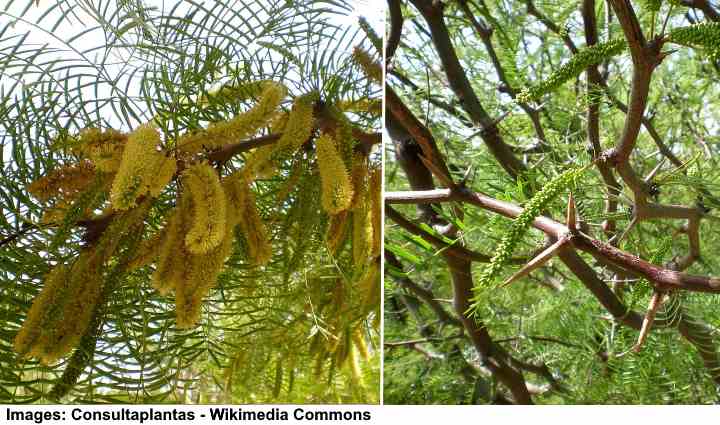
Chilean Mesquite flowers, leaves and thorns
White Mesquite Tree (Prosopis alba)
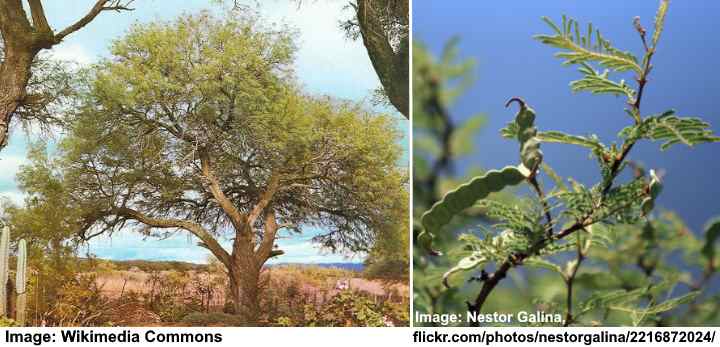
White Mesquite tree, immature seed pods and leaves
The white mesquite tree is a semi-evergreen tree with a rounded, spreading crown. The mesquite leaves are bipinnately compound with two or four pairs of paired divisions (pinnae). Similar to all mesquite trees, the white mesquite (Prosopis alba) blooms in spring with creamy-yellow flower spikes. After blooming, the 8-inch (20-cm) long edible seed pods appear.
The white mesquite tree is also called the white carob tree (in Spanish Algarrobo tree) due to the large dark seed pods that grow in late summer.
Black Mesquite Tree (Prosopis nigra)
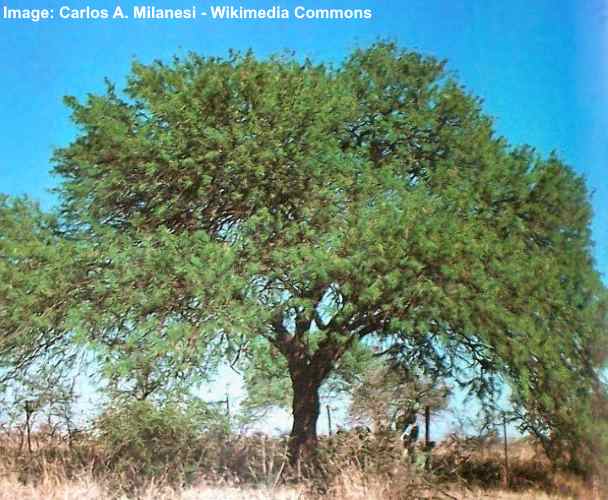
The black mesquite tree is native to South America and is smaller than the white mesquite tree. This Prosopis tree species grows between 13 and 32 ft. (4 – 10 m) tall and has a round-topped crown with a wide spread. Like Prosopis alba, the black mesquite tree has dense foliage. Also, tiny mesquite flowers grow in small bunches, and the tree produces pea-like seed pods.
Smooth Mesquite Tree (Prosopis laevigata)

Smooth Mesquite tree
The smooth mesquite tree is uncommon in Texas, Arizona, and South America. The mesquite leaves are long, pinnate leaves that have up to 50 leaflets on one petiole. Smooth mesquite trees also have long cylindrical pale-yellow flowers and long brownish-tan colored dangling seed pods.
Depending on the soil, the thorny shrub-like tree can grow between 3 ft. and 10 ft. (1 – 3 m) tall.
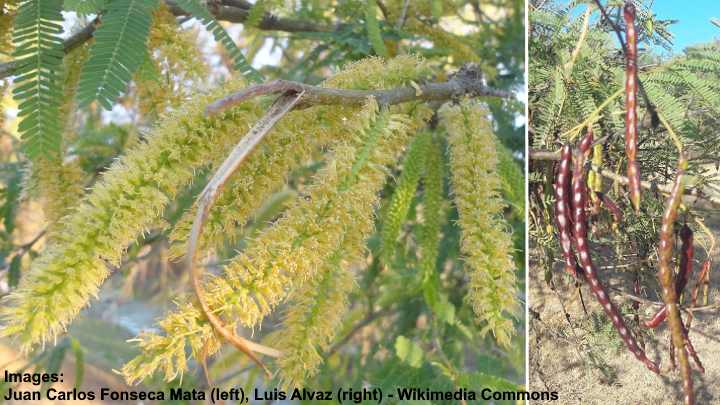
Smooth Mesquite flowers and seed pods
Creeping Screwbean Mesquite Tree (Prosopis strombulifera)
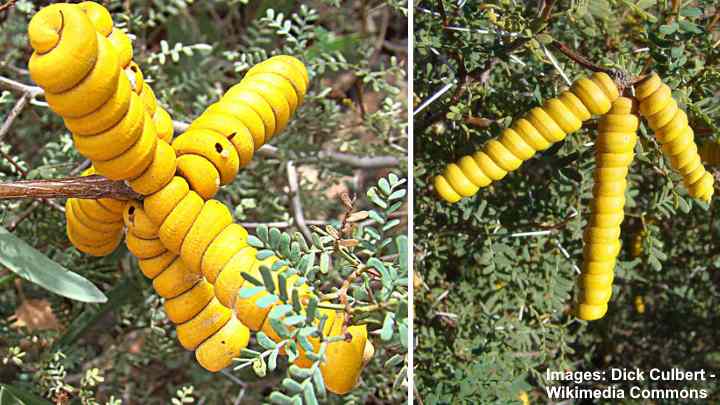
Creeping Screwbean Mesquite seed pods
The creeping mesquite tree has similar coiled seed pods to the screwbean mesquite. Also called the Argentine screwbean, this thorny shrub-like tree has waxy compound leaves, white spines, and tube-like flowers growing as yellow spherical flower heads. After flowering, yellow screw-like pods appear that contain brown, bean-like seeds.
Creeping mesquite trees grow in full sun and reach about 10 ft. (3 m) tall.
Related articles:
